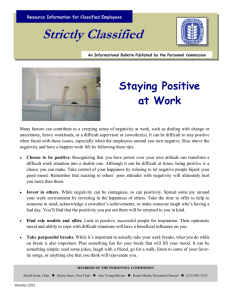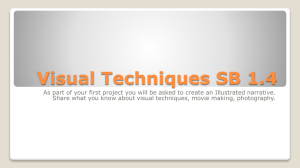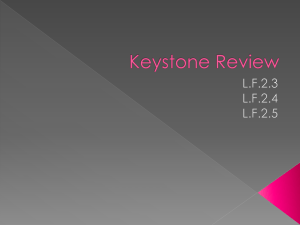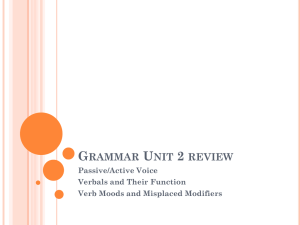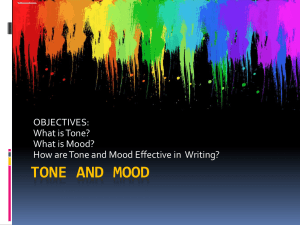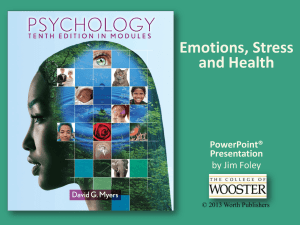Maureen Gaffney presentation to RI conference, Flourishing
advertisement
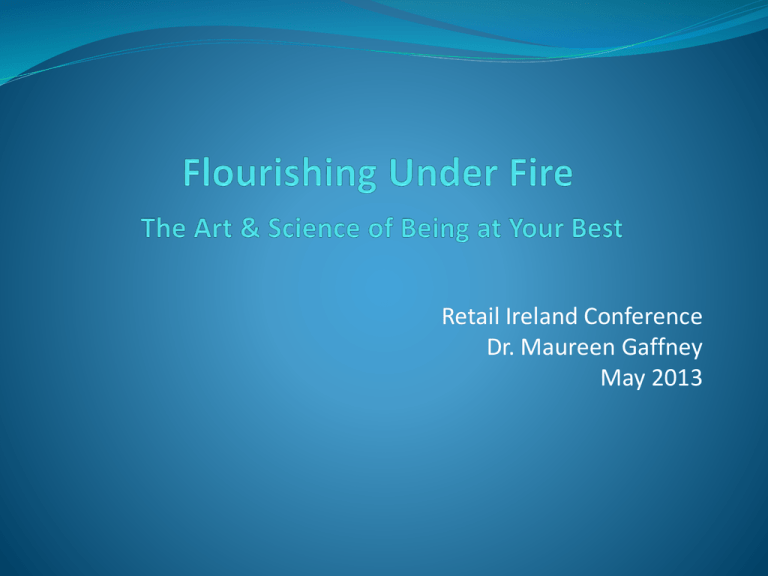
Retail Ireland Conference Dr. Maureen Gaffney May 2013 The Problem Statement Truth #1: The pressure for continuous & faster change is putting huge pressure our capacity to adapt to that change Truth #2: Developing our capacity to adapt & change e is our biggest challenge & our greatest opportunity to survive, recover & flourish in a sustainable way Why so much pressure to change ? Speed: ‘The world used to be a place where the big ate the small. Now the fast eat the slow.’ Klaus Schwab Relentless competitiveness Pressure to continuously replace products & services with more efficient ones Focus on services : increasingly defined as ‘a solution to a problem’ or ‘something that works’ Fear of being left behind : Anxiety that job & workplace may be changed at any moment by economic & technological forces that are anything but stable ‘Microsoft is always only two years away from failure’ Bill Gates ‘Only the paranoid survive’ Andy Gove Intel The complacency gap • A recent survey of customers of nearly 400 US companies revealed that only 8% of them described their experience as ‘superior’ • Yet, 80% of the companies surveyed believe that the experience they have been providing is superior. • This disparity should alarm any organisation that is competitive & serious about building sustainable success We KNOW how to change.... J. Kotter 1. 2. 3. 4. 4. 5. 6. 7. Ability to create a sense of urgency Get a good team – with skills, motivation & connections to make the change happen Create an enterprise vision – that people can vividly see, hear, feel, want Communicate the vision Remove obstacles out of people’s way so they can make change happen Change fast – create small wins Keep on changing Make change stick by creating new organisational culture Then why is change so often hit-andmiss or unsuccessful? Because change has both an internal & external aspect Over focus on structural change & neglect of internal change – how people are thinking & feeling Whether they feel they are flourishing - At Their Best ‘At work do you have the opportunity to do what you do best every day?’ When employees answer ‘strongly agree’ to this questions they are 50% more likely to work in a business with lower turnover 38% more likely to work in more productive unit 44% more likely to work in business with higher customer satisfaction At your best Being at your Best not just about IQ but EQ Longitudinal studies – IQ contributes only 20% to life success High EI accounts for 2/3 of difference between ‘star’ & ‘average’ performers & 4/5 of difference between ‘star’ & ‘average’ senior managers/leaders At Your Best CONNECTIVITY AUTONOMY USING YOUR VALUED COMPETENCIES High work satisfaction VITAL ENGAGEMENT High Positivity High Productivity The Problem ? Only 20% of people & 20% of business teams flourishing 20% are ‘languishing’ – functioning well below par, blocked, frustrated, ‘running on empty’ What Blocks Us from Flourishing ? Losing a very precise ratio of positivity to negativity The Little Meter in Your Brain Continually registering negative & positive emotional reactions to internal & external ‘events’ Each emotion triggers cascade of changes in thinking, in body & in behaviour Critical Positive-Negative Ratios Ratio of 3:1 – critical threshold & minimum platform for positive functioning Below 3:1 – the ‘languishing ratio’ Ratio 5:1 – the ‘Flourishing ratio’ Ratio of 12:1 - dynamics of flourishing break up For happy, sustainable personal relationships For individual wellbeing & optimum functioning For work & organisational success The Basic Emotions Liking/Love Joy Gratitude Contentment Anger Fear Sadness Shame Interest Hope Pride Humour Inspiration Awe Guilt Envy Jealousy Contempt* Disgust* Emotion Behaviour Thought Pattern The Power of Negative Emotions Negative designed to be powerful, ‘sticky’ & contagious Negativity ‘contaminating’ Loss more powerful impact than ‘equivalent’ gain Negative first impressions ‘stickier’ Need 9 ‘bits’ of positive information to reverse negative first impression Less than 4 new ‘bits’ of negative information to reverse positive first impression Negative mood stronger & longer lasting effects than positive mood Intense negative interactions powerful predictor of long-term outcome in relationships Trust easier to destroy than create Two Principles of Flourishing Consciously & Actively Build the Positive in yourself, in others & in organisations you care about Consciously & Actively Reduce the Negative in yourself, in others & in organisations you care about Building the positive Ten Strategies to Build the Positive 1. 2. 3. 4. 5. 6. 7. Build your capacity for happiness Set yourself goals Control your attention Always know your positive purpose Take charge of your mood Master the art of vital engagement Build meaning in your life - feeling that you matter & what you do matters 8. Build your resilience 9. Stop sabotaging yourself : How you can’t be driven crazy without your full cooperation 10. Embrace the future: Why optimism really counts Strategy 1 Build your capacity for happiness . 1 Life Success & Happiness – Which comes First? The predictive power of a smile Happiness & Health: Exercise, Body Mass, Smoking important factors- but positive feelings more important Persistent Negative Feelings Cut 10 yrs Off Your Life Persistent Negative Feelings Cut 10 yrs Off Your Life So are happy people insufferably selfpreoccupied? Positivity is Contagious (so is negativity....) One person's positivity directly causes another person to feel positive The more direct & face to face the interaction stronger the influence Effect spreads throughout social network - even to those you don’t know. Every positive colleague increases your happiness by 9% & each unhappy colleague decreases it by 7%. So if you can add three positive people to your network your positivity increases by nearly a third. 2. Why having ‘Life Projects’ counts Happiness Set Point Life circs 10% Genetic 50% Life projects 40% Strategy 5 Take charge of your mood How mood changes everything Feelings provoke mood Mood lasts two hours Mood affects virtually everything you think, remember, feel & do Mood is contagious -particularly mood of somebody you depend on So you can’t leave your mood at the door of your life The ‘Mood’ of a Group Emotional contagion happens in groups & spreads like virus The more emotionally interconnected a group, the longer have worked together, the stronger the moods expressed by individuals – the more contagion Mood at work counts – to individuals but also to productivity Negative mood affects in performance of entire group In cardiac unit where nurses’ general mood depressed, death rate among patients four times higher than on comparable units. Strategy 8 Build your resilience Flourish - not in spite of adversity but because of it: Stress –Related Growth Level of functioning Flourishing recovery Survival TIME Stage 1: Coping with immediate distress: Are we there yet? Why me? ‘Why us? Why now? ‘What if....?’ ‘Now what...? Affecting focus, concentration & productivity Stage 2. Understanding the meaning of what happened Stage 3: Building a new narrative About the kind of person/organisation that you think you are Worthy of love & respect? Or not? About what you expect of other people Can you trust others? Or not? About the future Full of opportunity? Or threat? Story is your lens on the world ‘Contamination’ Narrative Set-back or crisis seen as ‘a life that was once good has now gone bad’ forever spoiled, ruined, never to be again Sense of future robbed Energy trapped in despondency, & helplessness or continually going after goals no longer attainable ‘Redemption’ Narratives Admitting the scale of the crisis & setback & accepting new reality Unwelcome yes, but intrinsic to growth that followed Crisis as positive turning point - not as end but beginning of something new Refocus big picture – reconnect to deepest values – who you are & what is really important to you Strategy 10 Cultivate optimism Remarkably little evidence that optimists EVER worse off than pessimists Optimism & human power to adapt wired same way in the brain Be ready to respond to both threat AND opportunity by activating positive & negative expectations Learning to ask transformative questions 1. How are we different in positive way – not in spite of but because of what happened? 2. Is there anything about what happened that allows us to do something that otherwise we could not have done? Or would not have done? The answers are the drivers of post-stress growth The Incredible Frailty of Predictions.... 1984 Economist experiment The classic experiment – 284 experts making 27,000 long & short term predictions ‘Foxes’ & ‘Hedgehogs’ ‘In this world the optimists have it, not because they are always right, but because they are positive. Even when wrong they are positive, and that is the way of achievement, correction, improvement and success. Educated eyes-open optimism pays; pessimism can only offer the empty consolation of being right. The one lesson that emerges is the need to keep trying. No miracles. No perfection. No millennium. No apocalypse. We must cultivate a sceptical faith, avoid dogma, listen and watch well, try to clarify and define ends, the better to choose means’.

